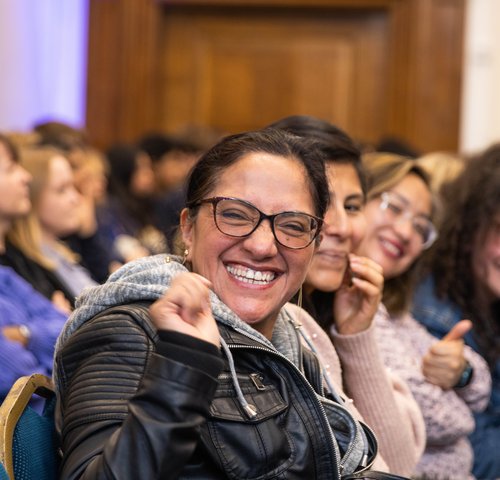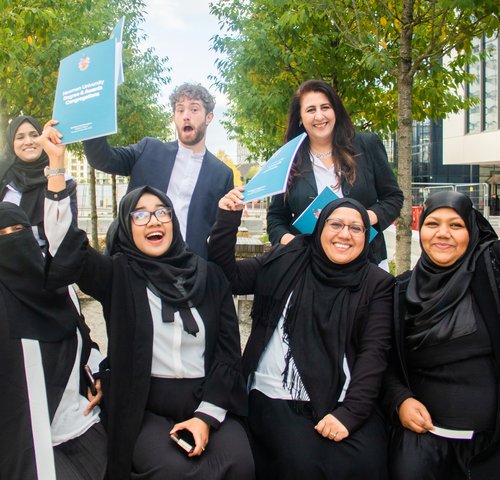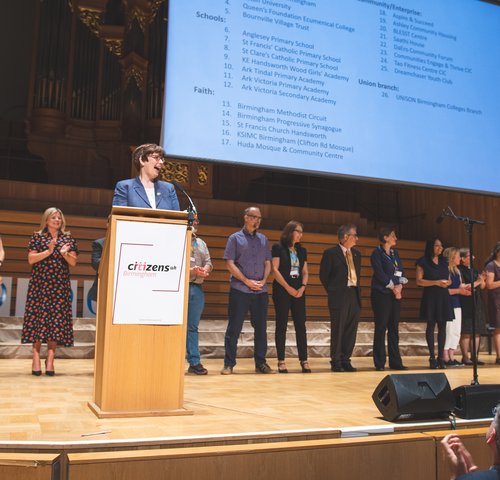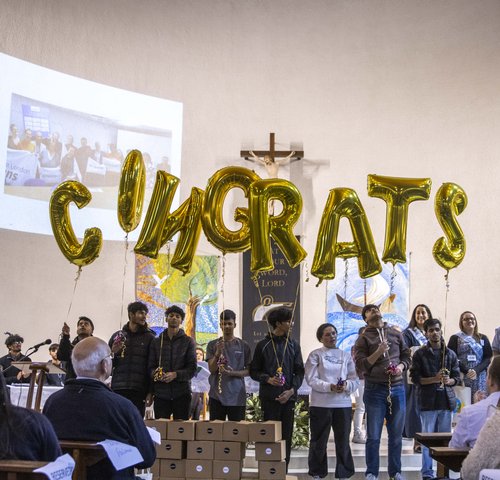Hendon School Youth-led Community Engagement and the Mental Health Campaign: Stamp Out Stigma
Hendon School Youth-led Community Engagement and the Mental Health Campaign: Stamp Out Stigma
-Noelle Doona, Assistant Headteacher at Hendon School
'Education is for improving the lives of others and for leaving your community and world better than you found it.’ - Marian Wright Edelman
Hendon School is in the London Borough of Barnet. It is a large and diverse comprehensive school with 1,250 students and over 130 staff. 47% students are in receipt of the pupil premium grant, 68% students have English as an additional language. 37% of our students are on the SEND register and we have two resourced provisions, for hearing impairment and autism. A significant number of our students live in areas that are in the top 10% most deprived in the UK (top 5% most deprived in London). Like many schools, we face a range of challenges, but they do not prevent us from wanting the best outcomes for all our students.
Nothing else to be said, job done, or so it should be! This is a mantra that I believe as educators, we would like to leave as our legacy. It is often easy to recount stories of inspirational young people who appear to go the extra mile to accomplish the things that they are passionate about and make a real difference. However, for many of us, where success is measured almost exclusively by academic standards – with the immense pressure on resources and a lack of adequate funding – it can prove difficult to hold on to, and safeguard, the role that schools can play in the wider community.
Henry Morris, who was Secretary to the Cambridgeshire Education Committee in the 1920s, once wrote that in the village school there should be no ‘leaving school!’ As a local school, it should be able to enhance the quality of life for the community it served. It should not be an escape from reality but, rather, provide enrichment and transformation for those within the community. This idea still resonates almost 100 years later. Schools are an integral part of any community. Understanding the opportunities and tackling the challenges that can come with serving a diverse community are central to a school’s success. Schools and communities are intrinsically linked and we can’t expect students to leave their baggage at the door and collect it as they leave.
We have a range of social issues in our community replicated across the UK: homelessness, overcrowding, drugs, gangs, domestic violence, hate crime, and high levels of childhood poverty, to name but a few. These are issues we and many schools deal with on a regular basis. As schools, we should be educating for life. A school cannot successfully teach its curriculum if we are unable to take a more holistic approach to the needs of the student and their family. Real education and school transformation can only effectively take place where there are strong community connections that work together to take action to improve. Where this happens, students are more likely to develop a responsible attitude to school and the community. They are more likely to achieve, stay in school, have a better sense of well-being and play a more active role in society. However, the reality can be more difficult to achieve.
The introduction of a national curriculum for citizenship was an important development as far as linking schools to their wider communities was concerned. Schools were encouraged – if not asked – to educate for life. Sir Bernard Crick, who was appointed to head up an advisory group on citizenship education, said about the group’s final report in 1998 (report which then became known as the Crick Report, and which led to the introduction of citizenship as a core subject), that ‘Citizenship is more than a subject. If taught well and tailored to local needs, its skills and values will enhance democratic life for all of us, both rights and responsibilities, beginning in school and radiating out. A noble thought, but more than 20 years later, the subject still fights for parity on the timetable and an adequate number of trained, passionate staff to deliver it effectively. In my own school, this too is the case and something we are working to change. However, Crick’s words have always resonated with me; they exemplify my passion for making a difference. I want students to develop the skills to be empowered to lead the change that they want to see in their own communities. Developing young committed citizens who know why they should, and how they can, make a difference, underpins my work.
How many of us have witnessed lessons where students have been set the task to write a letter to the Headteacher, a local Councillor, or the Prime Minister about an issue they are being taught? Have these letters stayed in books or have students been encouraged to send these, thus actively engaging with the issue. This is an easy way for students to understand that they have a voice and are encouraged to use it even at the simplest level. Education is about teaching students the skills and supporting them to be active participants in society, enabling them to be successful and in charge of their own destinies. There is no better way to do that than to get them to explore their hopes and fears and look at how they can effectively, and positively, challenge the world they live in. For students receiving a response from a letter there is a sense of joy and acknowledgement that someone has heard their voice, even if impact is low. In return, this can help to develop the idea of civic engagement. We know that most students enjoy participating when it is a topic that they are interested in. Huge numbers regularly take part in School Council elections, mock elections, and social action in a variety of local and national campaigns. The hunger for this type of engagement is there but schools tend to be constrained by overcrowded curricula, a lack of resources, and the necessary training to develop this effectively in the classroom and beyond.
Schools are ideally placed for students to work together to explore issues. Together students, parents and staff can identify themes that want to see changed (developing the skills of communication, negotiation and compromise). As a result, they collaborate, develop roles, leadership skills, and take action on something that they care about. These community action campaigns should be a fundamental right for all, engaging young people in campaigning on the issues that they care about. Students learn the importance of being engaged citizens, understanding that they have power and a part to play. It is up to each school to ensure that it provides the opportunities for young people and staff to engage and this should be encouraged.
At Hendon, we provide a range of opportunities but these, in the past, have been without any wider community involvement. We realised that we were doing our projects to the community rather than engaging with the community. Resulting campaigns were weak and often didn’t succeed as we lacked the effective power to be successful. In 2008, a fortuitous email arrived: I was introduced to the idea of Community Organising. The message that reached me reflected the type of work and engagement that I really wanted to develop in our school.
As a school, we adopted a model championed by Staples and Delgado, which focused on youth community organising. We have used Youth-Adult collaborative partnership organising and our most successful campaign used a Youth-Led with adult allies supporting approach. Introducing these ideas into the school was not without the critics: many said it couldn’t be done.
Youth community organising is a relatively new, but rapidly growing, approach. It gives young people the ability to build on their lived experiences and priorities, exercising power to affect change that directly impacts on their well-being and sense of belonging. As a student’s time at school is relatively short, critics question the sustainability of this approach. I believe it is, if young people are meaningfully connected to the community this will often continue when they leave school. In addition, students new to the school can see that they really can make a difference and are keen to participate. Students are starting to embrace the idea of life-long community participation.
There is much written about schools developing citizens and leaders of the future. As a society, I believe, we cannot expect young people to play a vital role in their community if we neglect what they can offer today. A lack of engagement in the community can create visible challenges in the future. If young people feel disenfranchised from an early age, it becomes more difficult to engage them in playing a positive and active role later on in life. There have been a number of initiatives to try and encourage schools increase engagement. I believe that in delivering a high-quality citizenship programme with a clear active community engagement component, we can do this. Everyone has the ability to be an effective citizen if encouraged and supported properly: supported to develop their own social capital and the confidence that their voice will be listened to. As a school we have to empower children to grow and develop their leadership capacity and to express it practically.

Our school values are “Believe, Achieve, Lead and Belong” and student leadership and participation are at the heart of what we do. The aim for all students is that they believe they have the ability to be what they want and can achieve whatever they set their minds to. Students are effectively able to lead and should understand that they belong not just to the school, but also a range of local, national and international communities.
All students in our school are members of Student Voice, it is their school and they should be able to share opinions and shape what happens. Each student experiences democracy for themselves through negotiation and compromise as they listen to, and debate, different points of view. As a group, they work together to make decisions about how they should use their vote. Where students want to tackle an issue, they are supported to find others in the school who have similar interests and set up action teams to tackle these. I believe we should never say no to an idea. Students should be encouraged and supported to undertake change on the issues that they are passionate about. There is still important learning taking place if their idea is not successful or has unintended outcomes.
A tragedy rocked the school, in August 2014, when our Headteacher sadly completed suicide. This loss, and the community’s associated need to recover from this tragic incident, were the catalyst to create the mental health and wellbeing team. None of us could foresee the long-lasting impact that this community action would have on all of us.
As the school came to terms with what had happened, one student took the lead in terms of how we could respond. The need to do something was immense but it took a long time before the community could effectively engage in responding to what had happened. The student set about talking and listening to how his peers and the staff wanted to respond. He identified six students who were passionate to take action. They conducted a campaign and identified that they wanted to raise awareness of mental health and reduce the stigma that people faced in speaking about their mental health challenges. The SOS – Stamp Out Stigma – Campaign was born. Soon after, fate seemed to intervene, when we learned about an opportunity to apply for funding for a social action project and the idea for (the first) student-led mental health conference took shape.
The students held a number of listening campaigns. Hosting a range of different events in school, as well as reaching out to other schools, listening to over 1,500 people. Common themes identified from personal testimonies included long waits, a lack of provision and the difficulty in navigating what support was available in the area. The team then spent time researching, identifying self-interest, building power within the community and developing relationships along the way. Initially, the decisions were taken by the adults with the students suggesting ideas and being guided as to what they had to do. As the team developed, it was clear that they were able to make more of the decisions and extended their work across the community. It took courage initially to let the students lead, but they rose to the challenge and never failed to impress those that went on the journey with them.
In the first year, there were many highlights:
- Students met with the local Council’s Voice of the Child coordinator to discuss issues around mental health and made a film to be shown at CAMHS highlighting current issues that young people faced.
- Students negotiated, and regularly met, with the Chief Executive of the local Mental Health Trust to raise issues. They gained funding for a local mental health app and secured their signature for the youth mental health charter.
- The Chair of the local Council’s Health and Wellbeing board publicly supported the work. She helped with introductions to other power players.
- Students attended the annual Council meeting – the first students to do this – where they were able to submit questions, discuss ideas with the council, whilst also receiving positive responses.
- Students also secured an agreement from the leader of the Council and the opposition to prioritise mental health. They agreed to a number of areas that they were willing to focus on. By working together and holding them to account, the Council went further than many of their initial commitments.
If it appears that everything went smoothly for the team, frankly, it didn’t. It was in these moments when some of the best learning took place. Nothing fazed the team as they worked to overcome numerous obstacles. The signing of the Charter was the most problematic issue that they faced. The Charter was to be the centre piece of the first conference, but the Head of the local Mental Health Trust would not agree to sign the Charter. Undeterred, the students undertook many trips to her office with flowers and cakes, finding solutions to every concern she raised. Still, she would not agree to sign. Then, with just a few days to go, she said that she was unable to attend the conference! The students organised another cake trip and negotiated that she would attend for just 30 minutes but not sign the Charter. To ensure she did not change her mind the students immediately tweeted and emailed all delegates confirming that she would be attending. On the day, again undeterred, some of the team spent an hour negotiating with her (she told them she had freed up her diary for the afternoon) to encourage her to sign; just 10 minutes before the launch, she finally said yes! The students’ resilience and ability to engage led to her later attending their second conference, offering the support of her team and contacts from the Mental Health profession. She also paid for the development of a mental health app and some funding for the second conference.
The first conference was an overwhelming success. One delegate wrote “I just wanted to congratulate you on a wonderful conference today. It was a privilege to come and speak. It's brilliant to see how motivated young people are to better understand mental health and make a difference - please do not underestimate the impact you've had not only on your generation, but the younger children following in your footsteps. The charter signed today will save lives, of that I am sure.” - Rachel W
It was this evaluation that ensured that team went from strength to strength.
Initially a one-year project, the team had numerous individual and group successes. This spurred them on to continue. They knew that they had made a difference across a variety of communities. The students talked about being fortunate to have an opportunity to take part in such an important campaign. They were excited that they had been able to develop a range of skills and felt that many students their age would not have the same opportunity. The literature in this field suggests students who are actively engaged are more likely to succeed and remain active citizens; we can see this within our team.
They have had an immense impact. Over 40 students have been members of the team, giving over 4,000 hours of volunteering. They’ve hosted three student-led conferences and a summit. They also have a voice in local and London-wide mental health work.
The team started with two simple aims:
- to get people talking about mental health
- improve the facilities in the community.
They have made a real difference in these two areas. The team have earned a reputation for themselves and have achieved eleven awards (local, national and international). These are the icing on the cake! However, these awards have helped the team to get the “power players” to take them seriously and work collectively to tackle the issue. Twelve of the team are actively engaged with community work outside of school. The students are positive about their experience and being part of the team. Here is what a few of them have had to say:
“The second mental health conference for me was absolutely amazing. I'm so grateful to have been a part of the event and been given the opportunity to lead… I'm glad to see change happening, to see the effect our work and what raising awareness has done for us as students, the team and our school - it's truly a phenomenal and fantastic team to be part of and I'm happy to say that I'm part of it.” - Chika
"Being part of the team is an exceptional opportunity to learn amazing lifelong skills!” - José
“At first, I joined the mental health team as I wanted to start community work. I soon realised that mental health was a big topic and I wanted to be one of the people who would kick start a conversation.’’ - A’mari
“This student led project has made a significant impact on our local community. As a school we have made a continuous effort to destigmatise mental health. We have gained transferable skills that can be applied to a variety of situations. As young pupils it is vital for us to gain exposure to these sorts of things before we enter the workforce. Mental Health is something very close to my heart, being able to do something about this issue has changed my life and I would like to think I have done something to support others.”- Soufia
“Being part of the mental health team has given us as much back as we have given towards the cause.” - Eddie
The students continue to tackle issues through the SOS – Stamp Out Stigma – Campaign. They consider themselves the guardians of the legacy left by the tragedy. They believe and can talk about their own experiences and are advocates for the role young people can have in being catalysts for change. The team are all leaders in their own right. Having been on a journey of self-discovery, we can see the shoots of a lifelong commitment to community engagement. Many of the early members of the team, who have left Hendon are still involved in community organising and mental health work. Others are actively pursuing a career in mental health.
Community engagement is vital for the success of schools. However, it has to be acknowledged that it is not easy to achieve. Even when a school values the importance of whole school engagement, has staff who have community awareness, are passionate and ready to support, there are still many barriers to overcome. Support, time, money and resources are essential to the successful implementation of community action. However, I believe all school can find ways to increase engagement, even with small changes to current practice.
I am passionate about the fundamental need for schools to play a more active role in their communities. I believe that community engagement should be the core purpose of all schools and as, educators, we must find ways rise to this challenge. It is possible, although not easy, as we are seeing it happen in a variety of schools across the UK. This approach to community engagement must, however, be met with the desire for change, sufficient resources, including training and recognition from central government. There needs to large-scale research, not anecdotal case studies into the impact on educational achievement and behaviour in the UK. Currently, much of the research is US-based or on a micro-scale. Research also into how community engagement in a wider context should also look at a community joined up approach to tackling wider social issues. Schools are increasingly expected to independently tackle these social problems, and this should not be the case. However, in partnership with others, we can build power, and take action. We can develop sustainable engaged citizens with the skills to be agents of change. If successful, this type of community approach could bring about the start of a revolutionary change in education and beyond the school gates, as a result I believe that all our communities will be in safe hands.
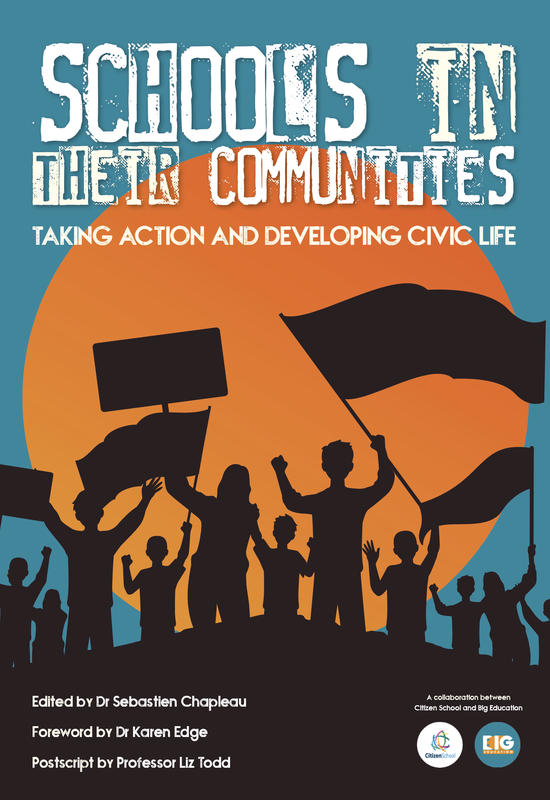
Schools in their Communities
This is an extract from Schools in their Communities; Taking action and developing civic life by Sebastien Chapleau.
Click below to download your free e-book and read more case studies on schools involved in Community Organising

Citizens UK is made up of hundreds of member organisations that are committed to taking action together for social justice and the common good.
We believe that faith, education, trade union and community organisations play a vital role as civil society institutions with deep and long-standing roots in their local areas. Through voluntary participation in these organisations, people build relationships, trust, vision and hope - and learn how to work constructively with those they might disagree with, to focus on what they have in common.
